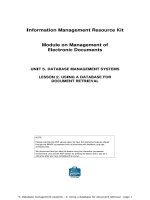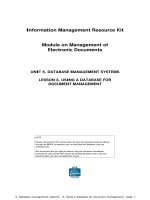Distributed Database Management Systems - vu_Lec_16
Bạn đang xem bản rút gọn của tài liệu. Xem và tải ngay bản đầy đủ của tài liệu tại đây (165.58 KB, 14 trang )
Distributed Database
Management Systems
Lecture 14
DHF
• The inputs required for DHF
– The set of partitions for owner
– Member relation
– Semi-join predicates between owner
and member
Virtual University of Pakistan
2
DHA
• Care in case of multiple owners, like
ASIGN
• Fragmentation selection depends:
1- One with better Join Characteristics
2- One used in more applications
• Second one is straight forward, we
should try to facilitate heavy users;
the first one needs more
considerations
Virtual University of Pakistan
3
DHF
• For the first point;
– Join is performed on smaller relations, that
increases efficiency
– The join can be performed in parallel in
case of simple graphs, that improves
efficiency as well; simple graph means
PAY1
PAY2
EMP1
EMP2
Virtual University of Pakistan
4
DHF
• demonstrates two things
1-Derived fragmentation may follow a
chain, like
PAY-EMP-ASIGN
2-Typically, more than one
fragmentation options are there,
which one adopted is an allocation
problem discussed later
Checking for Correctness
Completeness: for PHF depends on Pr’,
and in DHF, completeness of owner Pr’,
and the referential integrity constraint
Reconstruction: Involves Union in both
Virtual cases
University of Pakistan
5
Checking for Correctness
Completeness: for PHF depends on Pr’, and
in DHF, completeness of owner Pr’, and
the referential integrity constraint
Let R be member S be owner
Fs = { S1,S2,…Sn}
‘A’ the common attribute
t[A] = t’ [A]
Virtual University of Pakistan
6
Reconstruction:
Involves Union in both cases
FR = {R1,R2,….Rn}
R = U Ri ∀ Ri ∈FR
Virtual University of Pakistan
7
Disjoint ness:
Simple in PHF if the pi in Pr’ are
mutually exclusive; in DHF,
guaranteed in case of simple join
graph, however in case of
partitioned join graph it is hard to
establish
Virtual University of Pakistan
8
Vertical Fragmentation (VF)
• Vertical subset of relation
• A VF of a relation produces
fragments R1, R2, …. Rn, each of
which contains subset of attributes
of R and PK of R.
• Objective is to produce smaller
relations, so that most of the
applications run on smaller
relations; so they become fast.
Virtual University of Pakistan
9
Vertical Fragment
• Vertical fragmentation is more
complicated, since more
alternatives exist.
• VF is mainly based on heuristics
Virtual University of Pakistan
10
Example of VF
CUST
A/C# Na
me
Delta = ΠA/C#, Name, Branch (CUST)
Beta = ΠA/C#, Bal (CUST)
Virtual University of Pakistan
AB10
1
Bal
Sae 4535
ed
AB20 Lae
2
eq
DeltaAB20 Sal
3
ma
A/C# Na
Bran
me
AB10chSha
9
an
AB10 Sae
MTN
1
ed
AB20 Lae LHR
2
eq
Bran
ch
MTN
45632 LHR
.34
67839 Beta
LHR
.87A/C# Bal
45.32
AB10MTN
4535
1
AB20 45632
2
.34
11
Two Alternatives of VF
• Grouping: Starting with single
attribute VFs and then
combining different attributes
Virtual University of Pakistan
12
Two Alternatives of VF
• Splitting: Starting from the whole
relation and then breaking it down
analyzing the nature of
applications
• Later suits better to DDB
environment; results nonoverlapping fragments; so
discussed here
Virtual University of Pakistan
13
Thanks









